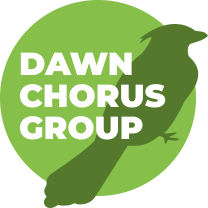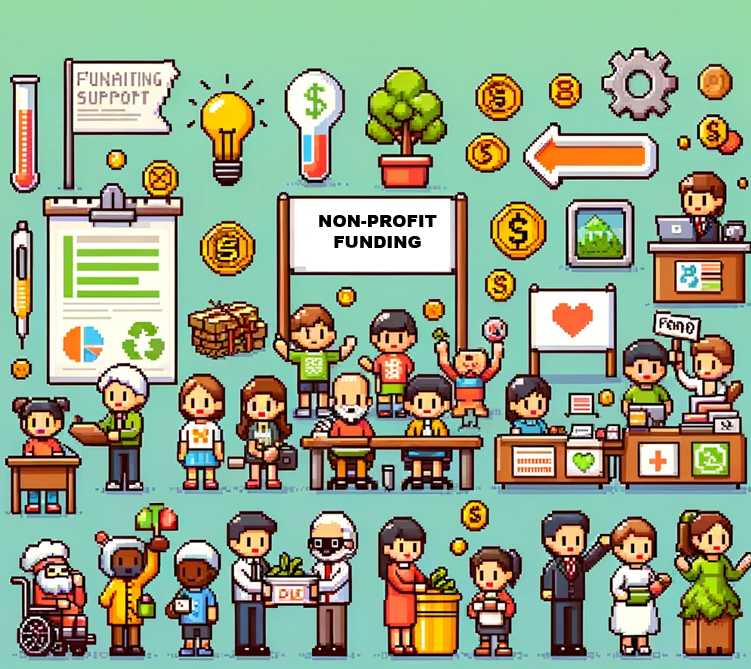Updated on January 17th with our new Funding Readiness Assessment. Check it out at the end of this blog!
In a world where societal issues continue to mount, nonprofits play a crucial role in addressing various social, environmental, and cultural challenges. However, their impact is often hindered by a significant obstacle.
Funding.
Understanding and choosing the right funding model is vital for any nonprofit aiming to sustain and grow its operations. This blog delves into the complexities of nonprofit funding, drawing insights from the comprehensive analysis by William Landes Foster, Peter Kim, and Barbara Christiansen, as outlined in their Spring 2009 article in the Stanford Social Innovation Review.
The Challenge of Nonprofit Funding
Nonprofit organizations often excel at program creation but struggle with securing sustainable funding. In contrast to the for-profit sector, where financial clarity is more common, nonprofits frequently face a ‘financial fuzziness’. This lack of clarity can lead to poorly matched funding sources and the untimely demise of promising programs, especially in challenging economic times.
The Importance of a Defined Funding Model
Just as businesses have various models that dictate their operations and revenue streams, nonprofits also need clear, defined funding models. These models should focus solely on funding strategies instead of encompassing program services and funding. The complexity in nonprofit operations arises from the fact that beneficiaries of services are often not the ones providing the revenue, creating a unique challenge in defining an effective funding model.
Ten Nonprofit Funding Models
The research by Foster, Kim, and Christiansen identifies 10 funding models commonly used by large nonprofits in the United States. These models are not one-size-fits-all solutions but frameworks to help nonprofit leaders articulate and analyze their funding strategies. The models include:

1. Heartfelt Connector
Organizations using this model often address universal human experiences and emotions, like health crises, natural disasters, or social injustices. They have a broad appeal and can quickly mobilize public support and empathy. Their causes are typically easy to understand and relate to, allowing them to connect with a diverse and wide audience. These organizations are adept at storytelling and creating emotional resonance through their communications and campaigns..
This model leverages the power of storytelling and emotional engagement to connect with a broad audience. Strategies include creating compelling narratives around the cause, utilizing powerful imagery and testimonials in marketing materials, and organizing high-profile events and campaigns. Digital platforms are crucial for expanding reach and engagement, with a focus on social media, email marketing, and online fundraising campaigns. Partnerships with influencers and celebrities can amplify the message.
Challenges: Maintaining a consistent and compelling message can be challenging, and these organizations often face stiff competition for public attention.
2. Beneficiary Builder
These entities typically provide high-value services or experiences, such as education, healthcare, or cultural enrichment. The beneficiaries of these services often have a strong personal connection to the organization, like alumni of educational institutions or patients of medical facilities. The model relies on the beneficiaries’ sense of gratitude and loyalty. These organizations often have a long history and strong community reputations.
Beneficiary Builders focus on developing lasting relationships with those directly benefiting from their services. Strategies include personalized communication and engagement plans for past beneficiaries, organizing alumni events, and creating targeted campaigns for major gift solicitation. They also emphasize the impact of past support, showcasing success stories and long-term benefits of their programs. Legacy-giving programs and planned giving options are also key components.
Challenges: It requires a strong network of past beneficiaries and a robust system for maintaining relationships over time.

3. Member Motivator
Member Motivators are deeply integrated into the lives of their members, often aligning with their core values or interests. These include religious groups, hobbyist clubs, or issue-based organizations like environmental or human rights groups. The key characteristic is members’ strong sense of identity and community, which drives their willingness to contribute. The organization’s activities are often member-driven, and there is a strong sense of collective benefit among the participants..
The strategy for fundraising revolves around reinforcing the value of membership and the collective impact of members’ contributions. This includes creating exclusive member benefits, organizing member-only events, and providing regular updates on how funds are used. Member referral programs, as well as member recognition systems, can be effective. Regular surveys and feedback mechanisms help to understand member needs and tailor communications accordingly.
Challenges: Keeping members engaged and demonstrating the ongoing value of their contributions is vital.
4. Big Bettor
Big Bettor organizations are often mission-driven around a specific, sometimes niche, cause. They typically rely on a few large donors, such as foundations, wealthy individuals, or corporations, who are deeply committed to the cause. The funding is often project-specific and can be sizable, reflecting the donors’ commitment to making a significant impact. These organizations often can take risks and innovate due to the substantial backing of their donors.
In this model, cultivating deep, personal relationships with major donors is crucial. This involves understanding the donors’ passions and aligning them with the organization’s projects. Tailored communication and personalized updates on the impact of their contributions are essential. Hosting exclusive events for major donors and offering them direct communication with the organization’s leadership can further deepen their commitment.
Challenges: A high reliance on a few funding sources can be risky if donor priorities change. Diversification is key!
5. Public Provider
Public Providers work closely with government agencies and are often involved in delivering public services or goods. Their work often aligns with public policy goals, such as education, public health, or social services. They are characterized by their contractual relationships with government entities and compliance with specific government regulations and standards. These organizations are often critical in filling gaps in public service provision.
This model requires demonstrating effectiveness and efficiency in service delivery to secure government contracts and grants. Strategies include developing strong relationships with government officials, investing in rigorous program evaluation and data collection to prove impact, and actively participating in policy discussions related to their service areas. Networking with other public service providers and staying informed about changes in government funding priorities is also key.
Challenges: There can be heavy reliance on government policies and budgets, which may fluctuate with political changes.
6. Policy Innovator
These nonprofits are distinguished by their innovative approaches to social problems. They often operate in areas where traditional government programs have been ineffective or insufficient. Policy Innovators are typically evidence-driven, investing in research and data to prove the efficacy of their methods. They seek to influence public policy and government funding priorities through their demonstrated success and advocacy.
Policy innovators must effectively communicate their innovative approaches’ unique value and effectiveness. This involves investing in research and development, building cases through pilot programs, and collecting compelling data demonstrating impact and cost-effectiveness. Engaging with policymakers, presenting at conferences, and publishing findings can help influence government funding decisions.
Challenges: They must continuously prove their methods are effective and efficient compared to traditional approaches.
7. Beneficiary Broker
Beneficiary Brokers operate in competitive environments where the beneficiaries choose a service provider. They are often found in sectors like healthcare, education, and housing. These organizations focus on delivering high-quality services to attract and retain beneficiaries. They are adept at marketing their services and must often navigate complex government funding mechanisms.
The core strategy is to be the preferred choice among beneficiaries. These organizations focus on marketing their services effectively and ensuring high service quality. Strategies include conducting market research to understand beneficiary needs, developing strong branding and clear messaging, and implementing robust customer service practices. They also invest in feedback mechanisms to continually improve services and meet the needs of their beneficiaries.
Challenges: They operate in a competitive environment and must balance service quality with cost-effectiveness.

8. Resource Recycler
Resource Recyclers specialize in the collection and redistribution of in-kind donations. They have strong logistics and supply chain capabilities, managing the intake, sorting, and distribution of donated goods. These organizations typically have a wide network of corporate partners and are skilled at handling the varying and unpredictable nature of in-kind donations. Their operations are often heavily reliant on volunteers and community support.
Resource Recyclers focus on building and maintaining strong relationships with corporate donors and managing the logistics of collection and distribution efficiently. Strategies include developing a compelling case for why corporations should donate goods, creating efficient systems for inventory management and distribution, ensuring transparency, and reporting back to donors on the impact of their contributions. Networking and partnerships are key to expanding the range of in-kind donations.
Challenges: They must constantly adapt to the varying availability of in-kind donations and manage logistical challenges.
9. Market Maker
Market Makers fill a unique niche with a demand for services, but for-profit provision is inappropriate or prohibited. They often operate in sensitive areas like organ donation, certain health services, or conservation efforts. These organizations must balance ethical considerations with financial sustainability. They are characterized by their ability to navigate complex legal and ethical landscapes.
Market Makers need to balance revenue generation and mission focus. Strategies include identifying and cultivating a customer base willing to pay for services while attracting donors who understand the unique role of the nonprofit. Developing diverse revenue streams, such as fee-for-service, memberships, and donations linked to service delivery, can help sustain operations.
Challenges: Balancing the need to cover costs while staying true to their nonprofit mission can be challenging.
10. Local Nationalizer
Local Nationalizers have a broad, often national presence, but their impact and operations are localized. They typically address universally relevant issues that require local adaptation, such as community health, education, or social services. These organizations are characterized by a strong central brand and a network of local chapters or affiliates with a degree of operational autonomy. The model relies on a balance of national consistency and local relevance.
Strategy: The focus here is on leveraging the strength of a national brand while tailoring fundraising efforts to local needs and opportunities. Strategies include empowering local chapters with fundraising training and resources, creating national-level marketing campaigns that can be localized, and developing strong communication channels between the national office and local chapters. Collaboration and sharing of best practices across chapters are essential for consistency and effectiveness.
Challenges: Maintaining brand consistency and quality across diverse local chapters can be difficult.
Choosing the Right Model
Selecting the appropriate funding model depends on several factors, including the organization’s mission, the type of beneficiaries, the sources of potential funding, and the motivations of decision-makers in funding entities. Nonprofit leaders must understand the nuances of each model and determine which aligns best with their operational and strategic goals.
The Bigger Picture
For a nonprofit, aligning its mission with an effective funding model is not just about securing resources. It’s about ensuring long-term sustainability and maximizing impact. As nonprofits grow, a robust and scalable funding model becomes increasingly critical. Large-scale operations require tapping into preexisting funding markets with established decision-makers and motivations.
Implications for Nonprofits and Philanthropists
In today’s economic climate, it’s tempting for nonprofits to chase any available funding. However, staying true to a well-defined funding strategy is more critical than ever. Understanding these funding models is equally important for philanthropists to ensure that their investments are effective and aligned with their objectives.
Conclusion
The journey towards a sustainable and impactful nonprofit sector is complex, with funding being pivotal. By adopting a clear and suitable funding model, nonprofits can navigate the financial challenges that often impede their mission. It’s a step towards surviving and thriving in a landscape filled with challenges and opportunities.
Take the next step.
Embrace this opportunity to redefine your organization’s relationship with funding, adapt to the dynamic landscape of nonprofit finance, and amplify your impact in the community. Take our Funding Readiness Survey; we can help develop a diverse, dynamic strategy to bring in the resources that help you do the work!

